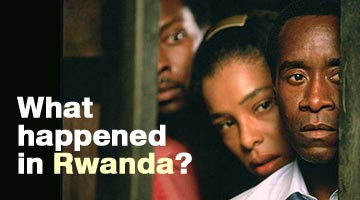
The film Hotel Rwanda -- released in 2004 but set to arrive in India this week -- is about a man called Paul Rusesabagina (played by Don Cheadle), who ran a hotel in Kigali, the Rwandan capital, that became a sanctuary for Tutsis and moderate Hutus fleeing the Rwandan genocide.
What is frightening is the relative ignorance surrounding that catastrophic event, considering it happened barely a decade ago, at a time when global communication systems were well in place. From rediff.com, a quick lesson in history.
What is the Rwandan Genocide?
It happened in 1994, over a period of 100 days, in the African state of Rwanda. An estimated 9,37,000 Tutsis and moderate Hutus were assassinated by Hutu extremists. The killings were brought to an end only when the Tutsi-dominated expatriate rebel movement -- known as the Rwandese Patriotic Front -- overthrew the Hutu government and seized power.
Why wasn't it talked about?
It was, actually, but global indifference at the time made it seem much smaller than it actually was. In fact, apart from the frighteningly large number of people killed, the genocide is famous because of the way the West reacted to it. First World countries had information about the killings before they began, and yet, even after coverage by the international media, no one intervened.
The United States, then led by President Bill Clinton, was also well informed, but decided to stay out, fearing a political backlash similar to one after an earlier attempt to help Somalia. Shockingly, even the United Nations refused to authorise its peacekeeping operation to end the killings.
How did it all come about?
This is a fairly complicated story. Rwanda was, initially, controlled by a Tutsi royal family, with the Tutsi people comprising its upper class. There were Hutus among the nobility too, with no clashes among either tribe. After the First World War, Rwanda passed from the hands of the Germans (it had been given to them in 1890) to the Belgians. The latter changed the social strata, eliminating the Hutus from the nobility and making it an exclusive Tutsi class. Thanks to the Belgians, Tutsis were now privileged. For the next 20 years, they managed to get better education and better jobs than the Hutus. What the Belgians introduced was to haunt the country forever.
Following World War II, Rwanda moved towards independence. After elections in 1959, the nationalist Party of the Hutu Emancipation Movement -- better known as the PARMEHUTU -- came to power and began advancing the cause of the Hutu majority. The Tutsis were suddenly seen as feudal overlords. Over 20,000 of them were killed, and 200,000 fled to neighbouring countries. A one-party rule based on Hutu nationalism was established. Over the years, more and more Tutsis were killed, culminating in the genocide.
Why did it happen?
There are a number of theories that try and explain this. Some blame it on the kind of European ideas of race that led to the Holocaust in Germany. Others blame economics, and competition for the scarce but rich land. Still others believe it was a shift of power from Francophone to Anglophone that led to instability.
In 1985, the Tutsi Rwandese Patriotic Front was formed. By 1990, Tutsi diaspora in refugee camps had begun voicing protests about being forced out of what they considered their own country. Tensions mounted as Hutus prepared to react. There were radio and press campaigns referring to Tutsis as inhuman, with subtle hints at violence against them. Radical Hutu groups began amassing weapons. Interestingly, the killings were partly financed with money embezzled from international aid programs. An approximate $134 million was spent on preparation for the genocide, with $4.6 million spent on crude weapons alone.
On April 6, 1994, a jet carrying the Hutu Presidents of Rwanda and Burundi was shot down. Prime Minister Agathe Uwilingiyimana took control, but was assassinated a day later by the presidential guard. The killings had begun.
Was it an organised massacre?
It came across as one. Organised bands of militia known as the Interahamwe began rounding up and killing all the Tutsis they could capture. Roadblocks sprang up around the country. Even ordinary citizens were urged, on government-sponsored radio, to kill their neighbours. Those who refused to kill were often murdered themselves.
The aftermath
After it ended, there were intermittent acts of revenge against ethnic Hutus. Thousands fled into Congo. On May 17, 1994, the UN finally conceded that genocide may have occurred. Towards the end of 1996, as refugees began returning, the government began genocide trials. The UN set up the International Criminal Tribunal for Rwanda, currently based in Tanzania.
Today, Rwanda continues to struggle with a settlement. The good news is, on March 31 this year, the Democratic Forces for the Liberation of Rwanda finally condemned the genocide and announced they were ending their civil war.







